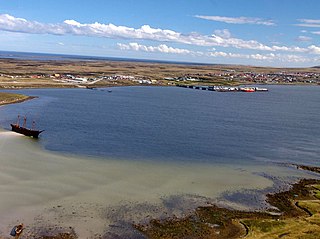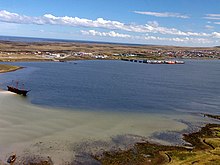
The history of the Falkland Islands goes back at least five hundred years, with active exploration and colonisation only taking place in the 18th century. Nonetheless, the Falkland Islands have been a matter of controversy, as they have been claimed by the French, British, Spaniards and Argentines at various points.

HMS Endeavour was a British Royal Navy research vessel that Lieutenant James Cook commanded to Tahiti, New Zealand and Australia on his first voyage of discovery from 1768 to 1771.

The Battle of the Falkland Islands was a First World War naval action between the British Royal Navy and Imperial German Navy on 8 December 1914 in the South Atlantic. The British, after their defeat at the Battle of Coronel on 1 November, sent a large force to track down and destroy the German cruiser squadron. The battle is commemorated every year on 8 December in the Falkland Islands as a public holiday.

Stanley is the capital city of the Falkland Islands. It is located on the island of East Falkland, on a north-facing slope in one of the wettest parts of the islands. At the 2016 census, the city had a population of 2,460. The entire population of the Falkland Islands was 3,398 on Census Day on 9 October 2016.

TV Sir Tristram (L3505) formerly RFA Sir Tristram, is a Round Table-class landing ship logistics that was converted to a Special Forces Training Vessel in 2008. She was launched in 1966, and accepted into British Army service in 1967. As with others of her class, she was transferred to the Royal Fleet Auxiliary in 1970, and was crewed by British officers and Hong Kong Chinese sailors. The ship saw service in the Falklands War of 1982, and was badly damaged at Fitzroy on 8 June.

USS Franklin, nicknamed "Big Ben," was one of 24 Essex-class aircraft carriers built during World War II for the United States Navy, and the fifth US Navy ship to bear the name. Commissioned in January 1944, she served in several campaigns in the Pacific War, earning four battle stars. In March 1945, while launching strikes against the Japanese mainland, she was badly damaged when a single Japanese dive bomber struck her with two bombs. The attack resulted in the loss of 807 of her crew and Franklin became the most heavily-damaged United States aircraft carrier to survive the war. The complement of Franklin suffered 924 killed in action during the war, the worst for any surviving U.S. warship and second only to that of USS Arizona.

HMS Plymouth was a Royal Navy Rothesay-class frigate. In 1982, Plymouth was one of the first Royal Navy ships to arrive in the South Atlantic during the Falklands War.

Pamir was a four-masted barque built for the German shipping company F. Laeisz. One of their famous Flying P-Liners, she was the last commercial sailing ship to round Cape Horn, in 1949. By 1957, she had been outmoded by modern bulk carriers and could not operate at a profit. Her shipping consortium's inability to finance much-needed repairs or to recruit sufficient sail-trained officers caused severe technical difficulties. On 21 September 1957, she was caught in Hurricane Carrie and sank off the Azores, with only six survivors rescued after an extensive search.

Guerrière was a 38-gun frigate of the French Navy, designed by Forfait. The British captured her and recommissioned her as HMS Guerriere. She is most famous for her fight against USS Constitution.

Picton Castle is a tall ship used for deep-ocean sail training and long distance education voyages. The ship was the subject of the television series Tall Ship Chronicles which documented her second voyage around the world in 2001. The ship has carried out seven world voyages to date - completing the seventh one in 2019. While flagged in the Cook Islands, the ship's unofficial home port is Lunenburg, Nova Scotia.

Stanley Harbour is a large inlet on the east coast of East Falkland island. A strait called "the Narrows" leads into Port William.

HMS Tiger Bay was a Z-28-class patrol boat operated by the British Royal Navy, previously the Argentine Coast Guard vessel PNA Islas Malvinas (GC-82), which was seized at Port Stanley by the crew of HMS Cardiff on 14 June 1982 following the Argentine surrender during the Falklands War.

Leif Höegh & Co is a shipping company founded in 1927 by Norwegian Leif Høegh (1896-1974). Since 2006 the company has been structured as two separate entities, Höegh Autoliners and Höegh LNG, with Leif Höegh & Co acting as a common holding company.

Roquebert's expedition to the Caribbean was an unsuccessful operation by a French naval squadron to transport supplies to Guadeloupe in December 1809 at the height of the Napoleonic Wars. Over the previous year, British Royal Navy squadrons had isolated and defeated the French Caribbean colonies one by one, until by the autumn Guadeloupe was the only colony remaining in French hands. Cut off from the rest of the world by British blockade squadrons that intercepted all ships coming to or from the island, Guadeloupe was in a desperate situation, facing economic collapse, food shortages and social upheaval, as well as the impending threat of British invasion. In an effort to reinforce and resupply the colony, the French government sent four vessels to the West Indies in November 1809 under Commodore François Roquebert. Two of the ships were 20-gun flûtes carrying supplies and troops. The two others were 40-gun frigates, ordered to protect the storeships on their journey from the British forces operating off both the French and Guadeloupe coasts.

Lady Elizabeth was a British ship built in 1869 by Robert Thompson Jr. of Sunderland. Robert Thompson Jr. was one of the sons of Robert Thompson Sr. who owned and operated the family ran shipyard J. L. Thompson & Sons. Thompson Jr. eventually left the family business in 1854 to start his own shipbuilding business in Southwick, Sunderland. She was 658 tons and was classified as a barque cargo sailing ship with one deck and three masts. She had a keel and outer planking made from American rock elm and a fore end made from English elm. The stem was made of teak and English oak with an iron floor as the deck. The ship also had copper and iron fastings. The ships was also registered in London under the name Wilson & Co. Messrs Wilson & Co. was based out of Sydney, Australia. The ship carried a comparative classification under American Lloyd's as "First class-third grade"

SS Imo was a merchant steamship that was built in 1889 to carry livestock and passengers, and converted in 1912 into a whaling factory ship. She was built as Runic, renamed Tampican in 1895, Imo in 1912 and Guvernøren in 1920.
Victory was built by Fenwick & Co, Sunderland in 1847, and owned by Willis, Gunn and Co and later owned by Wilson and Cook. She was a 578- or 579-ton barque that brought some of the first immigrants from England to Dunedin in July 1848. She also called at Wellington, New Zealand, in August 1848. There was an advertisement that gave her weight as 700 tons, but, given that her captain in 1851 was Mullens, it was unlikely to be another ship.

Lyman D. Foster was an ocean-going, cargo-carrying, wooden sailing vessel named after the son of a provisions merchant who invested in vessels. Built at the Hall Brother's shipyard at Port Blakely, Washington (state), U.S.A. in 1892, she was 184 feet long with a 39-feet beam and 15.4 feet depth, and had a tonnage of 778 GRT.
Junella was a fishing trawler, best known for her service with the Royal Navy during the Falklands War. She was built in 1975 for J Marr & Son, a Hull-based fishing company. On 11 April 1982 she was taken up from trade by the British government and commissioned into the Royal Navy. She was fitted with Second World War era minesweeping gear at Rosyth Dockyard, manned by Royal Navy sailors and allocated to the 11th Mine Countermeasures Squadron. She sailed on 26 April but was unable to commence sweeping until after the 14 June Argentine surrender. In the meantime she was utilised to transfer troops and stores between ships and landed special forces troops at San Carlos. Demining operations commenced on 21 June. Junella returned to the United Kingdom on 11 August, carrying a defused Argentine mine.




















